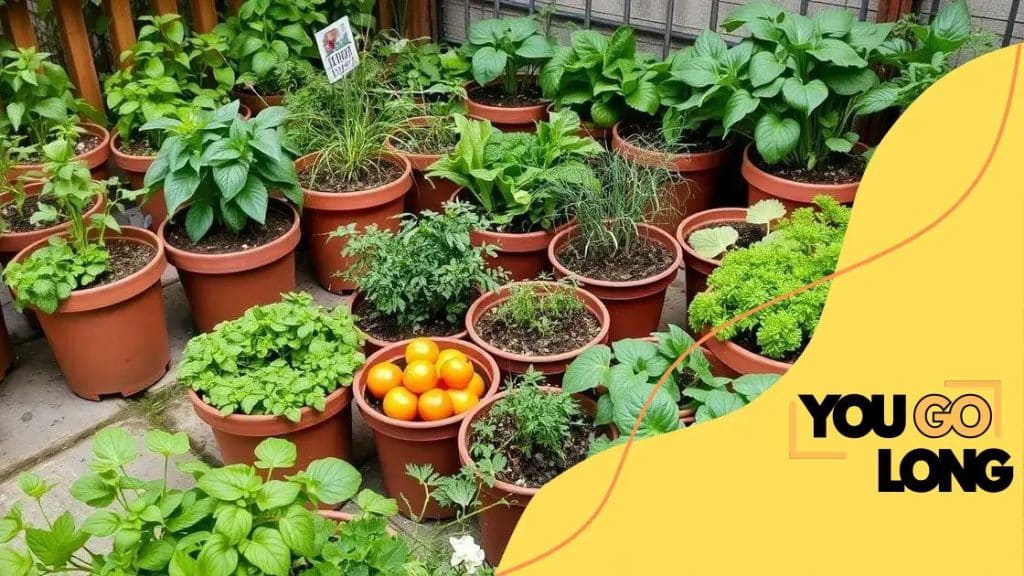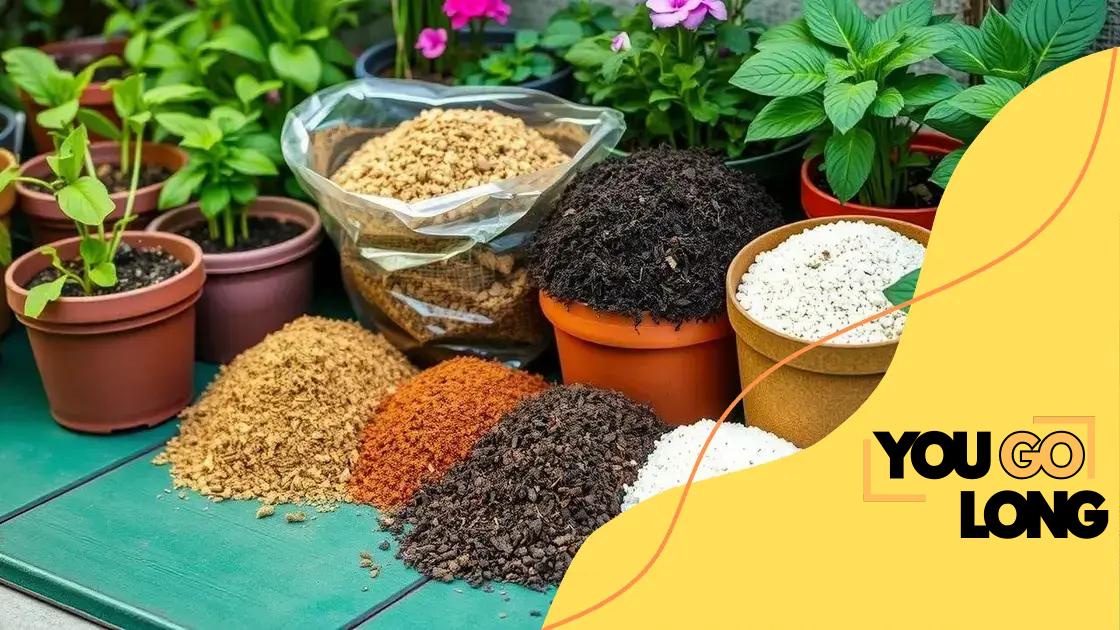How to grow an edible garden on your patio

Advertisement
To grow an edible garden on your patio, select suitable containers, use quality potting mix, ensure proper watering, and maintain your plants throughout the seasons for optimal growth and harvest.
Are you looking to maximize your outdoor space? How to grow an edible garden on your patio is a delightful solution. Imagine picking fresh herbs and veggies just steps away from your kitchen. Curious about how to get started? Let’s dig in!
Choosing the right containers for your garden
Choosing the right containers for your garden is essential for a thriving edible garden on your patio. The right containers not only enhance the aesthetics but also provide the optimal environment for your plants to grow. When selecting containers, consider size, material, and drainage.
Consider Size and Depth
The size of your containers can significantly affect plant growth. For larger plants like tomatoes, deep containers are necessary to support root growth. Smaller herbs, such as basil or mint, can thrive in shallower pots.
Advertisement
- Use at least 10-gallon containers for tomatoes.
- Herbs generally need 1-2 gallons.
- Consider the growth habits of your plants.
- Avoid overcrowding; give each plant enough space.
Next, think about the materials. Common options include plastic, clay, and ceramic. Plastic pots are lightweight and often cheaper, making them a popular choice. However, clay pots are porous and allow for better air circulation, which can be beneficial for plant health.
Ensure Proper Drainage
Drainage is crucial for healthy plants. Without proper drainage, roots can become waterlogged, leading to root rot. Ensure your containers have holes at the bottom to allow excess water to escape.
- Consider adding pebbles at the bottom for extra drainage.
- Check for drainage holes before purchasing.
- Use potting soil that retains moisture but also drains well.
In summary, the containers you choose for your patio garden will impact your plants’ success. By selecting the correct size, material, and incorporating proper drainage, you’re setting your edible garden up for success. Enjoy the process and watch your garden flourish!
Advertisement
Best herbs and vegetables for a patio garden
When it comes to starting an edible garden on your patio, choosing the best herbs and vegetables is crucial. The right plants can thrive in containers and bring flavor to your meals. Here are some popular options that are easy to grow and care for.
Herbs to Grow in Containers
Herbs are perfect for patio gardens. They can add taste to dishes and are often compact, making them ideal for small spaces. Consider planting:
- Basil – Loves warm weather and is great for pasta dishes.
- Parsley – A versatile herb that can be used in many recipes.
- Chives – Adds a mild onion flavor to meals and are easy to maintain.
Another great option is cilantro, which is popular in salads and Mexican cuisine. These herbs not only taste great but also require minimal care.
Top Vegetables for Your Patio
Vegetables can also flourish in container gardens. Look for those that grow well in small spaces. Some great choices include:
- Cherry Tomatoes – They thrive in pots and yield a delightful harvest.
- Radishes – Quick-growing and don’t need much depth.
- Lettuce – Can be harvested multiple times and grows fast.
Don’t forget about peppers! They come in various varieties and can add some spice to your dishes. With proper care and the right selection, your patio can become a vibrant spot for fresh produce.
Soil and nutrient management tips

Soil and nutrient management is vital to the success of your edible garden on your patio. Healthy soil ensures your plants receive the necessary nutrients for robust growth. To start, it’s important to choose the right potting mix for your containers.
Selecting the Right Potting Mix
A good potting mix should provide proper drainage and retain moisture. Look for a mix that includes components like peat moss, perlite, and compost. These ingredients help ensure your plants have access to the nutrients they need to thrive.
- Peat moss retains moisture while allowing air to circulate.
- Perlite improves drainage and prevents soil compaction.
- Compost adds essential nutrients and beneficial microorganisms.
Once you have your mix, consider how to enrich your soil over time. Regularly adding organic matter can greatly benefit your plants. For example, compost can be mixed into the soil every few weeks to boost nutrient levels.
Watering and Nutrient Delivery
Proper watering is equally important. When you water, you should ensure that you are not overdoing it. Overwatering can leach nutrients from the soil, while underwatering can stress your plants. A good rule of thumb is to keep the soil consistently moist but not soggy.
- Check soil moisture by sticking your finger into the mix.
- Water when the top inch of soil feels dry.
- Use a balanced liquid fertilizer every four to six weeks.
In addition to regular watering, consider using slow-release fertilizers. These can provide your plants with a steady flow of nutrients, supporting continuous growth. Through effective soil and nutrient management, you will create a thriving patio garden that yields fresh produce.
Watering techniques for container gardens
Watering techniques are essential for maintaining a healthy edible garden on your patio. Proper watering ensures that your plants receive the moisture they need without becoming waterlogged. Understanding how to water your container garden effectively can lead to vibrant, productive plants.
Deep Watering
Deep watering is crucial for container plants. Instead of frequent light watering, aim to water thoroughly, allowing moisture to penetrate the soil deeply. This encourages roots to grow deeper, making your plants more resilient.
- Water until you see it draining from the bottom of the pot.
- Make a habit of checking soil moisture before watering.
- Deep watering is especially beneficial during dry spells.
Additionally, early morning is the best time for watering. This allows plants to absorb moisture before the heat of the day, reducing evaporation.
Use of Drip Irrigation
Drip irrigation systems can be a fantastic choice for container gardens. These systems deliver water directly to the base of your plants, minimizing waste and ensuring even moisture levels. They also reduce the risk of fungal diseases caused by wet foliage.
- Consider automated timers to simplify the process.
- Adjust drip rates based on plant needs and weather conditions.
- Ensure all emitters are functioning properly.
Another technique is to group your pots together. When plants are close, they can share moisture and create a microclimate. This can reduce overall watering needs and improve plant health.
In summary, by adopting effective watering techniques like deep watering and using drip irrigation systems, you can ensure that your patio garden thrives. With proper moisture management, your plants will flourish and yield delicious produce throughout the growing season.
Maintaining your edible garden throughout the seasons
Maintaining your edible garden throughout the seasons is key to enjoying fresh produce year-round. Each season brings its own challenges and opportunities for growth. Understanding how to care for your plants in each phase will help ensure a vibrant garden.
Spring Care
Spring is the perfect time to plant new seeds and seedlings. Start by checking the soil conditions. It’s important to loosen the soil so that air and nutrients can reach the roots. Add organic compost to enrich the soil as it warms up.
- Plant cool-season crops like lettuce, peas, and radishes early.
- Regularly water your young plants to help them establish.
- Watch for pests as the weather warms; early intervention is key.
Be prepared for fluctuating temperatures. Using row covers can protect young plants from unexpected frosts.
Summer Strategies
In summer, keeping your garden well-watered is essential as temperatures rise. Make sure to check soil moisture often. Mulching will also help retain moisture and suppress weeds.
- Water deeply and less frequently to encourage deep root growth.
- Harvest regularly to promote new growth; for example, cut basil and let it regrow.
- Consider shade cloth for tender plants during extreme heat.
As the season progresses, continue to monitor plants for signs of stress or pests. Regular pruning can help increase airflow and reduce disease.
Fall Forward
Fall is a great time for planting fall crops such as kale and spinach. These crops can thrive in cooler temperatures and can produce well into the winter. Start preparing your garden for winter by cleaning up dead plant material which can harbor pests and diseases.
- Cover bare soil with mulch to protect it from heavy frost.
- Consider planting a cover crop like clover to improve soil health.
- Bring any potted plants indoors before the first frost.
By maintaining your edible garden throughout the seasons with these practices, you’ll enjoy fresh food from your patio all year long. With attention and care, your garden can be a sustainable source of delicious produce.
FAQ – Frequently Asked Questions about Maintaining an Edible Garden
What should I plant in the spring for my patio garden?
In spring, you can plant cool-season crops like lettuce, peas, and radishes, as well as herbs like basil and cilantro.
How often should I water my container plants?
It’s best to water deeply and less frequently, ensuring the soil is moist but not soggy. Check the top inch of soil for dryness before watering.
What soil is best for my potted plants?
A good potting mix should contain equal parts of peat moss, compost, and perlite to ensure good drainage and nutrient retention.
How do I protect my garden from pests?
Regularly inspect your plants for pests and consider using organic methods like neem oil or introducing beneficial insects like ladybugs.





